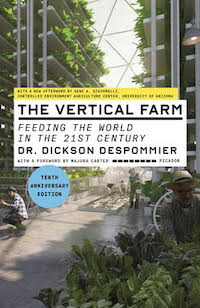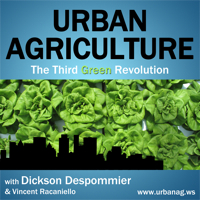 I get a lot of phone calls (mostly media interviews), requests for on-camera appearances, and a ton of e-mail, all asking me to define (usually in a simple, declarative sentence or two) what I mean by the term ”vertical farm”. Forget that I have written about this concept ad nauseam, and in much detail in my book, The Vertical Farm. In fact, I have only ever given one reply to that question. A vertical farm is nothing more complex in concept than a high-tech greenhouse that is stacked on top of itself, transforming it into a multi-storey growing space. Certain single-storey buildings also meet that criteria, as well, but are not divided inside to reflect floors. For example, some re-purposed warehouses with inside growing spaces that frequently exceed 30 feet in height also count as vertical farms (for examples see: Aerofarms, Green Sense Farms, Green Spirit Farms, FarmedHere, Spread). Single-floor buildings with a ceiling height of 10-12 feet are greenhouses, regardless of what goes on inside them. They have been around a long time, and while the strategies for growing indoor crops have evolved, many into to multi-layered systems (e.g., hydro-stackers, Tower Garden), i.e., “vertical farming” methods, the basic concept of a greenhouse has not changed much over the last 30 years. I do not include any version of them in my vertical farm concept.
I get a lot of phone calls (mostly media interviews), requests for on-camera appearances, and a ton of e-mail, all asking me to define (usually in a simple, declarative sentence or two) what I mean by the term ”vertical farm”. Forget that I have written about this concept ad nauseam, and in much detail in my book, The Vertical Farm. In fact, I have only ever given one reply to that question. A vertical farm is nothing more complex in concept than a high-tech greenhouse that is stacked on top of itself, transforming it into a multi-storey growing space. Certain single-storey buildings also meet that criteria, as well, but are not divided inside to reflect floors. For example, some re-purposed warehouses with inside growing spaces that frequently exceed 30 feet in height also count as vertical farms (for examples see: Aerofarms, Green Sense Farms, Green Spirit Farms, FarmedHere, Spread). Single-floor buildings with a ceiling height of 10-12 feet are greenhouses, regardless of what goes on inside them. They have been around a long time, and while the strategies for growing indoor crops have evolved, many into to multi-layered systems (e.g., hydro-stackers, Tower Garden), i.e., “vertical farming” methods, the basic concept of a greenhouse has not changed much over the last 30 years. I do not include any version of them in my vertical farm concept.
The vertical farm concept is about maximizing plant density to enable large numbers of people living in the built environment access to healthy, fresh vegetables year-round that are herbicide and pesticide-free. Skyscraper apartment buildings allow us to live comfortably in densely-populated urban settings. Vertical farms need to address the same density issue regarding how much of the edible plants we consume can be grown within the urban environment. Oh, and by the way, when the first skyscraper was proposed, it was accompanied by much controversy as to what actually constituted a skyscraper. OK, my definition of a vertical farm sounds easy enough to get your head around, but some may still have trouble distinguishing between a vertical farm and farming vertically inside a one storey structure.
A brief history of space flight might help by analogy to eliminate any remaining confusion as to what I mean by the term vertical farm. After WW II, the United States “inherited” a number of confiscated V-2 rockets, a single-stage weapon of mass destruction. We played around with them a while and got the feel of how to do rocketry before setting our sights on going to the moon. It was obvious that a one-stage rocket, no matter how big, was not going to do the job. But it wasn’t until the 1960’s that funding and political will combined to support The National Aeronautics and Space Administration in their development and deployment of a propulsion system that would finally free us from the pull of Earth’s gravity. After many failed attempts and some remarkable successes, the Saturn rocket, a massive three-stage affair, emerged from NASA’s R&D to do the job. The entire world was watching when, on July 20, 1969 Neil Armstrong stepped off the lunar lander module and into the history books.
So, how does this example apply to the vertical farm concept, and why do I insist on multi-storey greenhouses? You might still ask: “But doesn’t growing food indoors in a single-storey building in a stacked configuration qualify as a vertical farm”? In my view, the answer is still an emphatic no! Greenhouses do not achieve the plant densities needed to supply food for the millions of city dwellers that go to bed hungry each night, or for those that are actually starving. Insinuating hyper-dense food production facilities inside the city limits or just outside them is a game-changer, and if employed world-wide, would alter forever the way we access our food supply. Vertical farms offer the promise of finally being able to free up large swaths of land from traditional, soil-based agricultural practices, allowing abandoned farmland to return to their original ecological function of providing ecosystem services that promote healthy lives for all living things on Earth, including us (see: Sand County Almanac, by Aldo Leopold). In my own book, I advocate for skyscraper farms. I hope this corrects some widely-held misconceptions and allows us to re-focus on the real reason why vertical farms are essential if we are to live balanced lives, and not, as we are still doing, continue to live at the expense of every other creature on our fragile planet.
Image: Confluence of Rio Negro and Amazon Rivers (credit).


{ 0 comments… add one now }